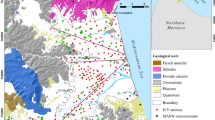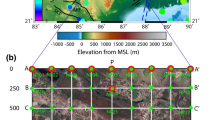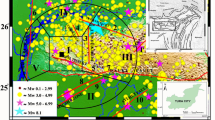Abstract
Even after a century, the site-specific seismic parameters are unidentified for seismically vulnerable Kangra city, which has witnessed a disastrous effect from the 4th April 1905 Kangra earthquake (Ms 7.8). This earthquake resulted in a varied damage distribution from the unconsolidated Quaternary sediments (alluvial fans to boulders conglomerates). The site-specific response analysis was carried out with multi-geophysical approach. The seismic methods, viz., ambient noise measurement and multichannel analysis of surface waves (MASW), were employed to understand local site conditions. horizontal to vertical spectral ratio (HVSR) peaks and their corresponding frequencies are interpreted for subsurface characterization. The fundamental frequency ranged from 4.23 to >20 Hz and the amplification factor varied from 1.5 to 6.67. The vulnerability analysis was carried out to identify the weak zone on the surface. The HVSR analysis shows that dominance of high fundamental frequency (f0 > 10 Hz) component also brings possibility of heavy damage from a near-source earthquake. While the results from MASW provide two-dimensional (2D) shear wave velocity (Vs), which are used for comparison and validation. These results provide important input for earthquake-resilient planning with resilient structures as per local site conditions.
Research highlights
-
Multi-geophysical seismic methods were tested in the complex geologically sedimentary environment of Kangra city, NW Himalaya, India.
-
Estimation of predominant frequency and amplification from ambient noise records.
-
Active seismic data acquisition of Multichannel Analysis of Surface Waves (MASW) for comparison and validation.
-
Evaluation of site-specific characteristics for vulnerability analysis and earthquake risk management.








Similar content being viewed by others
References
Aki K and Richards P G 2009 Quantitative seismology; University Science Book, California.
Ambraseys N and Bilham R 2000 A note on the Kangra Ms = 7.8 earthquake of 4 April 1905; Curr. Sci. 79 45–50.
Boschetti F, Dentith M C and List R D 1996 Inversion of seismic refraction data using genetic algorithms; Geophysics 61 1715–1727.
Capizzi P and Martorana R 2022 Analysis of HVSR data using a modified centroid-based algorithm for near-surface geological reconstruction; Geosciences 12(4) 147.
Dey S, Thiede R C, Schildgen T F, Wittmann H, Bookhagen B, Scherler D and Strecker M R 2016 Holocene internal shortening within the northwest Sub-Himalaya: Out-of-sequence faulting of the Jwalamukhi Thrust, India; Tectonics 35(11) 2677–2697.
Fäh D, Rüttener E, Noack T and Kruspan P 1997 Microzonation of the city of Basel; J. Seismol. 1 87–102.
Farrugia D, Galea P and D’Amico S 2020 Assessing seismic site response at areas characterized by a thick buried low-velocity layer; In: Earthquakes – from tectonics to buildings; Intech Open, https://doi.org/10.5772/intechopen.95277.
Gabas A, Macau A, Benjumea B, Bellmunt F, Figueras S and Vila M 2014 Combination of geophysical methods to support urban geological mapping; Surv. Geophys. 35 983–1002.
Gosar A 2017 Study on the applicability of microtremor HVSR method to support seismic microzonation in the town of Idrija (W Slovenia); Nat. Hazards, Earth Syst. Sci. 17 925–937.
Güler E and Afacan K B 2021 Assessment of shear wave velocity concept on the site specific analysis and its effects over performances of building codes; Revista De La Construcción J. Constr. 20(3) 527–543.
Hough S E, Bilham R, Ambraseys N and Feldl N 2005 Revisiting the 1897 Shillong and Kangra earthquakes in northern India: Site response, Moho reflection and a triggered earthquake; Curr. Sci. 21 1632–1638.
Hunter J A, Motazedian D, Crow H L, Brooks G R, Miller R D, Pugin A J M and Xia J 2010 Near-surface shear-wave velocity measurements for soft-soil earthquake-hazard assessment: Some Canadian mapping examples; In: Advances in Near-Surface Seismology and Ground-Penetrating Radar, pp. 339–359, https://doi.org/10.1190/1.9781560802259.ch21.
Kanai K 1957 Semi-empirical formula for the seismic characteristics of the ground; Bull. Earthq. Res. Inst. 35 309–325.
Kang S Y, Kim K H, Chiu J M and Liu L 2020 Microtremor HVSR analysis of heterogeneous shallow sedimentary structures at Pohang, South Korea; J. Geophys. Eng. 17(5) 861–869.
Khalili M and Mirzakurdeh A V 2019 Fault detection using microtremor data (HVSR-based approach) and electrical resistivity survey; Rock Mech. Rock Eng. 11 400–408.
Kumar P and Mahajan A K 2020 New empirical relationship between resonance frequency and thickness of sediment using ambient noise measurements and joint-fit-inversion of the Rayleigh wave dispersion curve for Kangra Valley (NW Himalaya), India; Environ. Earth Sci. 79 256.
Livaoğlu H and Irmak T S 2017 An empirical relationship between seismic bedrock depth and fundamental frequency for Değirmendere (Kocaeli–Turkey); Environ. Earth Sci. 76 681.
Mahajan A K 2018 Applications of two-dimensional seismic tomography for subsurface cavity and dissolution features detection under Doon valley, NW Himalaya; Curr. Sci. 115(5) 962–969.
Mahajan A K and Kumar P 2018 Site characterization of Kangra Valley (NW Himalaya, India) by inversion of H/V spectral ratio from ambient noise measurements and its validation by multichannel analysis of surface waves technique; Near Surf. Geophys. 16 314–327.
Mahajan A K, Galiana-merino J J, Lindholm C and Arora B R 2011 Characterization of the sedimentary cover at the Himalayan foothills using active and passive seismic techniques; Appl. Geophys. 73 196–206.
Mahajan A K, Kumar P and Kumar P 2021 Near-surface seismic site characterization using Nakamura-based HVSR technique in the geological complex region of Kangra Valley, northwest Himalaya, India; Arab. J. Geosci. 14 826.
Mahajan A K, Slob S, Ranjan R, Sporry R, Champati Ray P K and Westen C J 2007 Seismic microzonation of Dehradun city using geophysical and geotechnical characteristics in the upper 30 m of soil column; Seismol. 11(4) 355–370.
Mahajan A K, Thakur V C, Sharma M L and Chauhan M 2010 Probabilistic seismic hazard map of NW Himalaya and its adjoining area, India; Nat. Hazards 53(3) 443–457.
Middlemiss C S 1905 Preliminary account of the Kangra earthquake of 4th April 1905; Rec. Geol. Surv. India 32 258–294.
Middlemiss C S 1910 The Kangra earthquake of 4th April 1905; Geol. Surv. India Memoir 38 409.
Moisidi M, Vallianatos F, Kershaw S and Collins P 2015 Seismic site characterization of the Kastelli (Kissamos) Basin in northwest Crete (Greece): Assessments using ambient noise recordings; Bull. Earthq. Eng. 13 725–753.
Mokhberi M 2015 Vulnerability evaluation of the urban area using the H/V spectral ratio of microtremors; Int. J. Disaster Risk Red. 13 369–374.
Mucciarelli M and Gallipoli M R 2001 A critical review of 10 years of microtremor HVSR technique; Boll. Geofis. Teor. Appl. 42 255–266.
Mucciarelli M and Monacheri G 1998 A quick survey of local amplifications and their correlation with damage observed during the Umbro-Marchesan (Italy) earthquake of September 26, 1997; J. Earthq. Eng. 2 325–337.
Mucciarelli M, Contri P, Monachesi G, Calvano G and Gallipoli M 2001 An empirical method to assess the seismic vulnerability of existing buildings using the HVSR technique; Pure Appl. Geophys. 158(12) 2635–2647.
Nakamura Y 1989 A method for dynamic characteristics estimation of subsurface using microtremor on the ground surface; Quart. Rep. Railw. Tech. Res. Inst. 30(1) 25–33.
Nakamura Y 1997 Seismic vulnerability indices for ground and structures using microtremor; World Congress on Railway Research, Florence.
Nakamura Y 2000 Clear identification of fundamental idea of Nakamura’s technique and its application; Proceedings of the 12th World Conference on Earthquake Engineering, Auckland, New Zealand, 8p.
Nath R R, Kumar G, Sharma M L and Gupta S C 2018 Estimation of bedrock depth for a part of Garhwal Himalayas using two different geophysical techniques; Geosci. Lett. 5(1) 9.
NEHRP 2001 NEHRP recommended provisions for seismic regulations for new buildings and other structures (FEMA 368 and 369); 2000 Building Seismic Safety Council; National Institute of Building Sciences, Washington, DC.
Panzera F, Lombardo G, DAmico S and Gale P 2013 Speedy techniques to evaluate seismic site effects in particular geomorphologic conditions: Faults, cavities, landslides and topographic irregularities; In: Engineering Seismology, Geotechnical and Structural Earthquake Engineering, pp. 101–145.
Park C B, Miller R D and Xia J 1999 Multichannel analysis of surface waves; Geophysics 64(3) 800–808.
Paudyal Y R, Yatabe R, Bhandary N P and Dahal R K 2012 A study of local amplification effect of soil layers on ground motion in the Kathmandu Valley using microtremor analysis; Earthq. Eng. Eng. Vib. 11 257–268.
Pitilakis K 2007 Earthquake geotechnical engineering; Vol. 6, Springer.
Putti S P and Satyam N 2020 Evaluation of site effects using HVSR microtremor measurements in Vishakhapatnam (India); Earth Syst. Environ. 4 439–454.
Rajendran K, Parameswaran R M and Rajendran C P 2017 Seismotectonic perspectives on the Himalayan arc and contiguous areas: Inferences from past and recent earthquakes; Earth Sci. Rev. 173 1–30.
SESAME 2003 Site Effects assessment using AMbient excitations; http://sesamefp5.obs.ujf-grenoble.fr.
SESAME 2004 Guidelines for the implementation of the H/V spectral ratio technique on ambient vibrations, Rapport final.
Srivastava H N, Dube R K and Raj H 1987 Space and time variation in seismicity patterns preceding two earthquakes in the Himachal Pradesh, India; Tectonophys. 113 69–77.
Srivastava P, Rajak M K and Singh L P 2009 Late Quaternary alluvial fans and paleosols of the Kangra basin, NW Himalaya: Tectonic and paleoclimatic implications; Catena 76 135–154.
Stanko D, Markušić S, Strelec S and Gazdek M 2017 HVSR analysis of seismic site effects and soil-structure resonance in Varaždin city (North Croatia); Soil Dyn. Earthq. Eng. 92 666–677.
Tarabusi G and Caputo R 2016 The use of HVSR measurements for investigating buried tectonic structures: The Mirandola anticline, Northern Italy, as a case study; Int. J. Earth Sci. (Geologische Rundschau) 106 341–353.
Tuan T T, Scherbaum F and Malischewsky P G 2011 On the relationship of peaks and troughs of the ellipticity (H/V) of Rayleigh waves and the transmission response of single layer over halfspace models; Geophys. J. Int. 184 793–800.
Xia J, Miller R D and Park C B 1999 Estimation of near-surface shear-wave velocity by inversion of Rayleigh waves; Geophysics 64(3) 691–700.
Xia J, Miller R D, Park C B, Hunter J A, Harris J B and Ivanov J 2002 Comparing shear-wave velocity profiles inverted from multichannel surface wave with borehole measurements; Soil Dyn. Earthq. Eng. 22(3) 181–190.
Yousuf M and Bukhari S K 2020 Evaluation of seismically induced Soft Sediment deformation structures vis-a-vis their probable earthquake sources in Kashmir basin, NW Himalaya; J. Earthq. Tsunami 15(1) 2150003.
Acknowledgements
The authors thank the Central University of Himachal Pradesh (CUHP) for providing basic logistics. Authors also sincerely acknowledge the reviewers for their constructive input in improving the overall quality of the research. This research was done under the project entitled ‘Subsurface characterization and its environmental implications using engineering seismograph and ground penetrating radar’ with financial assistance from the Ministry of Earth Sciences, Govt. of India (grant no. MoES/P.O.(Seismo)/1(206)/2013).
Author information
Authors and Affiliations
Contributions
Praveen Kumar: Data acquisition, writing of the original draft, map preparation, review and editing. Ambrish Kumar Mahajan: Supervised the project, resources and critical feedback. Manuj Sharma: Data acquisition and processing.
Corresponding author
Additional information
Communicated by N V Chalapathi Rao
Rights and permissions
About this article
Cite this article
Kumar, P., Mahajan, A.K. & Sharma, M. Site effect assessment and vulnerability analysis using multi-geophysical methods for Kangra city, NW Himalaya, India. J Earth Syst Sci 132, 14 (2023). https://doi.org/10.1007/s12040-022-02032-7
Received:
Revised:
Accepted:
Published:
DOI: https://doi.org/10.1007/s12040-022-02032-7




